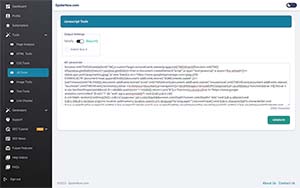Angular, React and Vue.js for JavaScript websites and frameworks
Crawling JavaScript websites requires specialized techniques and tools to effectively extract data.

Crawling JavaScript Websites
In the world of web crawling and data extraction, JavaScript has become both a boon and a challenge. While JavaScript enhances the interactivity and functionality of modern websites, it can also complicate the process of web scraping. In this guide, we'll delve into the intricacies of crawling JavaScript websites, exploring the techniques, tools, and best practices that can help you successfully extract data from them.Understanding JavaScript's Role in Web Pages
To grasp the challenges of crawling JavaScript-based websites, it's crucial to understand JavaScript's role in web pages. JavaScript is a versatile programming language used for client-side scripting, which means it runs directly in a user's web browser. Websites often rely on JavaScript to load dynamic content, display pop-ups, and perform various other interactive tasks. This dynamic behavior is what makes crawling JavaScript sites more complex than static HTML pages.
Traditional Crawling vs. JavaScript Crawling
Traditional web crawlers, like search engine bots, rely on simple HTML parsing to index web pages. They follow links, extract text and metadata, and store this information in their databases. However, these crawlers struggle when faced with JavaScript-heavy websites because they can't execute JavaScript code.
JavaScript crawlers, on the other hand, are designed to navigate JavaScript-rich pages. They execute JavaScript code, wait for dynamic content to load, and then scrape the updated DOM (Document Object Model). This approach allows you to access the same data that users see when interacting with the website.
Common JavaScript Crawling Challenges
Crawling JavaScript websites presents several challenges:
Dynamic Content Loading: Many websites use JavaScript to load content dynamically, making it inaccessible to traditional crawlers. You need to ensure your crawler can wait for and capture this content.
Single-Page Applications (SPAs): SPAs load most of their content using JavaScript after the initial page load. Crawling SPAs requires sophisticated techniques to navigate and extract data from multiple views.
Client-Side Routing: Websites with client-side routing rely heavily on JavaScript to change URLs and load new content. Handling these routes correctly is crucial for comprehensive crawling.
Anti-Scraping Measures: Some websites implement anti-scraping measures, such as CAPTCHAs and IP blocking, to deter web crawlers. Overcoming these obstacles requires creative solutions.
Effective Techniques for Crawling JavaScript Websites
To successfully crawl JavaScript websites, you'll need to employ a combination of techniques and tools:
Headless Browsers: Headless browsers like Puppeteer and Playwright enable you to automate web interactions, including JavaScript execution. They provide APIs for navigation, interaction, and data extraction.
Wait for Dynamic Content: Use functions provided by headless browsers to wait for elements to become available. This ensures you scrape content after it has been dynamically loaded.
Handle AJAX Requests: JavaScript often makes asynchronous AJAX requests to fetch data. Intercept and process these requests to obtain the data you need.
Render JavaScript: Some websites may use client-side rendering (CSR) frameworks like React or Angular. Consider using a tool like Rendertron to render pages on the server and crawl the fully rendered HTML.
User Agents: Set user agents to mimic different web browsers or devices. Some websites serve different content based on the user agent, and mimicking a real browser can help avoid detection.
Proxy Rotation: To circumvent IP blocking and anti-scraping measures, use proxy servers with rotation to distribute requests and avoid detection.
Best Practices for Ethical Crawling
While crawling JavaScript websites, it's essential to maintain ethical practices:
Respect Robots.txt: Always check a website's robots.txt file for crawling guidelines. Follow these guidelines to ensure you're not crawling where you're not supposed to.
Rate Limiting: Implement rate limiting to avoid overloading a website's servers. Crawling too aggressively can lead to temporary or permanent IP bans.
User-Agent Identification: Make sure your user agent identifies your crawler and provides contact information for site administrators in case of issues.
Scraping Policies: Understand and adhere to a website's terms of service and scraping policies. Some websites explicitly prohibit web scraping.
Building a JavaScript Crawler
Building a JavaScript crawler requires a combination of programming skills and the right tools. Here's a simplified example using Puppeteer, a popular headless browser library for Node.js:
const puppeteer = require('puppeteer');
(async () => {
const browser = await puppeteer.launch();
const page = await browser.newPage();
await page.goto('https://example.com');
await page.waitForSelector('.dynamic-content');
const data = await page.evaluate(() => {
const element = document.querySelector('.dynamic-content');
return element.textContent;
});
console.log(data);
await browser.close();
})();
Crawling JavaScript websites presents unique challenges, but with the right techniques and tools, you can extract valuable data from even the most dynamic and interactive sites. It's essential to stay updated with the latest developments in web crawling and adapt your techniques as websites evolve. Additionally, always prioritize ethical practices to maintain a positive relationship with website owners and administrators.
This is a detailed overview of crawling JavaScript websites without the use of bullet points. It covers the challenges, techniques, tools, and best practices necessary for successful web scraping in the world of JavaScript-rich web pages. Feel free to explore each topic further and adapt the techniques to your specific crawling needs.
The above information is a brief explanation of this technique. To learn more about how we can help your company improve its rankings in the SERPs, contact our team below.

Bryan Williamson
Web Developer & Digital Marketer

Web Developer & Digital Marketer
Digital Marketer and Web Developer focusing on Technical SEO and Website Audits. I spent the past 26 years of my life improving my skillset primarily in Organic SEO and enjoy coming up with new innovative ideas for the industry.













